The first time I heard a bass guitar slide, I was mesmerized. It was like the instrument was singing, weeping, and laughing all at once. That moment changed my perception of bass guitar forever, opening up a world of expressive possibilities I never knew existed. As I delved deeper into this technique, I discovered that slides weren’t just about creating cool effects—they were a gateway to a whole new dimension of musicality.
As a master’s degree holder in Contemporary Improvisation, I’ve explored various techniques across string instruments. Bass guitar slides have always fascinated me for their expressive potential, and I’m excited to share my insights with you. Whether you’re a beginner looking to add some flavor to your playing or an experienced bassist wanting to refine your slide technique, this guide will help you navigate the nuanced world of bass guitar slides, from basic techniques to advanced applications.
Understanding Bass Guitar Slides
Types of Bass Guitar Slides
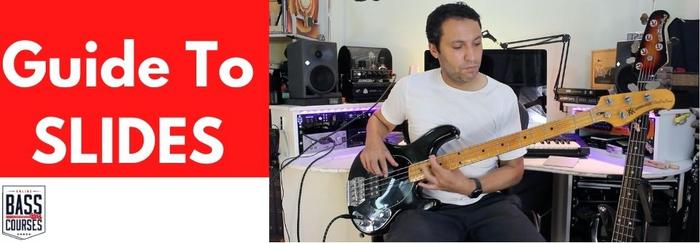
As we delve deeper into understanding bass guitar slides, it’s crucial to explore the various types of slides that form the foundation of this technique. In my years writing for Premier Guitar, I’ve encountered and analyzed numerous bass slide techniques. The most common types include the glissando, where you slide smoothly between two notes, and the portamento, a more subtle, voice-like transition. There’s also the hammer-on slide, combining a hammer-on with an upward slide, and its counterpart, the pull-off slide. For a more dramatic effect, octave slides involve sliding between notes an octave apart. Each type of slide contributes uniquely to your bass playing, offering different textures and expressive possibilities. Understanding these variations is key to mastering slides and integrating them effectively into your musical repertoire.
Benefits of Using Slides in Bass Playing
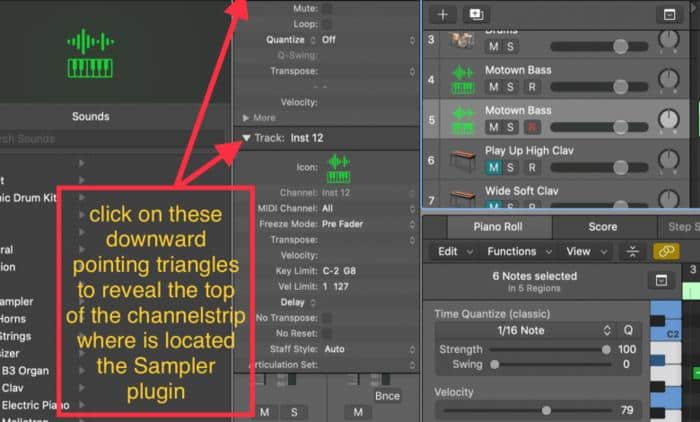
As an editor at ‘Acoustic Guitar’, I’ve witnessed firsthand the transformative power of using a slide on bass. The technique opens up a whole new realm of expressive possibilities, allowing bassists to seamlessly glide between notes and create fluid, vocal-like phrases. Slides add a soulful, emotive quality to bass lines, reminiscent of the human voice or a fretless instrument. In my experience with both acoustic and electric stringed instruments, I’ve found that slides can elevate simple bass parts into captivating melodic statements.
Moreover, slides enable bassists to explore microtonal territories, adding subtle nuances and inflections to their playing. This technique is particularly effective in genres like blues, rock, and country, where it can evoke a raw, earthy feel. By mastering slides, bassists can expand their sonic palette and develop a more versatile, expressive approach to their instrument, ultimately enriching their musical contributions across various styles and contexts.
Essential Techniques for Bass Guitar Slides
Proper Hand Positioning

In my years of teaching and writing slide bass guitar tutorials, I’ve found that proper hand positioning is the cornerstone of mastering slides. Your fretting hand should be relaxed yet firm, with your thumb resting on the back of the neck for support. Position your sliding finger (typically the ring or middle finger) at a slight angle, allowing the side of your fingertip to make contact with the string. This angle helps maintain consistent pressure and tone throughout the slide.
As for your plucking hand, maintain a loose grip on the slide between your thumb and index finger. This allows for quick transitions between sliding and regular playing. Remember, the key is to keep both hands relaxed and fluid. With practice, this positioning will become second nature, enabling you to execute smooth, controlled slides that enhance your bass lines and solos.
Controlling Slide Speed and Pressure
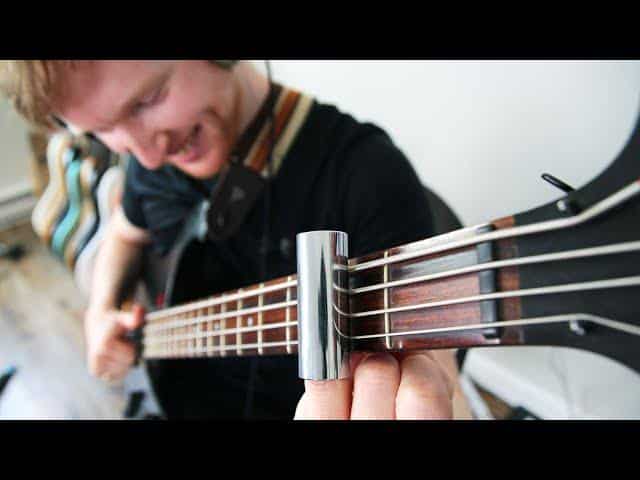
When it comes to controlling slide speed and pressure, my years of improvisation have taught me that finesse is key. For beginner bass slides, start by applying gentle pressure with your slide, just enough to make contact with the strings. Too much pressure can result in unwanted buzzing or muting. I’ve found that practicing with a light touch helps develop better control and cleaner tones.
As for speed, I always advise beginners to start slow. Gradually increase your slide speed as you become more comfortable. Remember, it’s not just about moving fast; it’s about maintaining precision. I often use a metronome to help me practice slides at different tempos, ensuring I can execute them accurately regardless of the song’s pace. By mastering these fundamental aspects of slide control, you’ll be well on your way to incorporating this technique seamlessly into your playing style.
Incorporating Slides into Your Playing
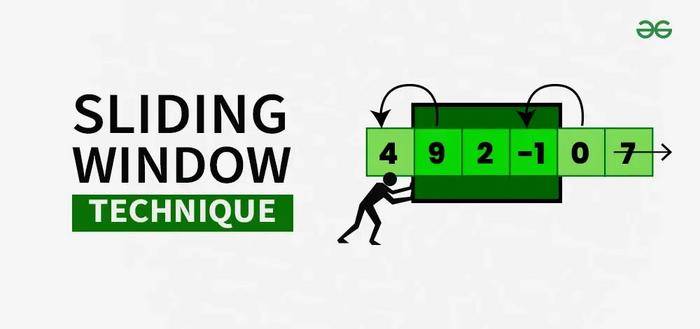
Incorporating slides into your playing is where the rubber meets the road in bass guitar slide lessons. From my years of interviewing professional bassists, I’ve learned that seamless integration is key. Start by identifying natural slide opportunities in your existing repertoire. Listen for moments where a slide could enhance the emotional impact or add a unique flavor to the bassline. Practice sliding into notes at the beginning of phrases or using slides as transitions between different sections of a song. Gradually increase the frequency and complexity of your slides as you become more comfortable. Remember, less is often more – use slides sparingly for maximum effect. As you progress, experiment with combining slides with other techniques like hammer-ons or pull-offs to create more intricate and expressive bass lines. The goal is to make slides an organic part of your playing, not just a flashy add-on.
Advanced Slide Techniques
Combining Slides with Other Techniques

As I discovered while working on “Jim Hall: Signature Licks,” combining techniques is crucial for developing a unique voice on any instrument. When it comes to sliding on bass, blending this technique with others can create a rich tapestry of sound. I’ve found that integrating slides with hammer-ons and pull-offs can produce fluid, legato phrases that sing. Try incorporating slides into your slap bass technique for a funky, percussive effect that adds dimension to your grooves. Another favorite of mine is using slides in conjunction with harmonics – this combination can yield ethereal, almost synth-like tones. Experiment with sliding into chord voicings for a more textured harmonic approach. Remember, the key is to practice these combinations slowly at first, focusing on clean transitions between techniques. As you gain proficiency, you’ll find that these hybrid approaches will significantly expand your expressive palette on the bass.
Using Bottleneck Slides on Bass
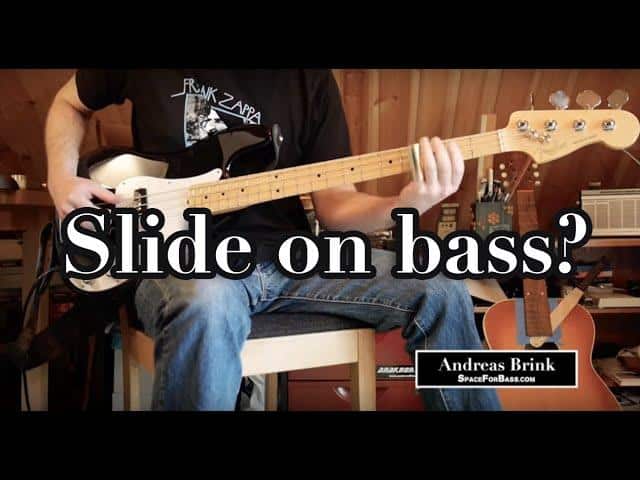
As a bass player and researcher, I’ve delved deep into the world of bottleneck slides on bass guitar. This technique, while unconventional, offers a unique sonic palette that can elevate your playing to new heights. To use a bottleneck slide effectively on bass, start by selecting a slide that fits comfortably on your finger – typically, a larger size than those used for guitar. Position the slide on your fretting hand’s ring or pinky finger, allowing your other fingers to mute the strings behind the slide. When playing, apply gentle pressure and move the slide parallel to the frets for clean, in-tune notes. Experiment with different slide materials, such as glass or metal, to find your preferred tone. Incorporating vibrato and subtle pitch bends can add expressive qualities to your slide bass lines, creating textures that are impossible to achieve with standard techniques.
Practicing Slides for Beginners
Basic Exercises to Improve Slide Technique
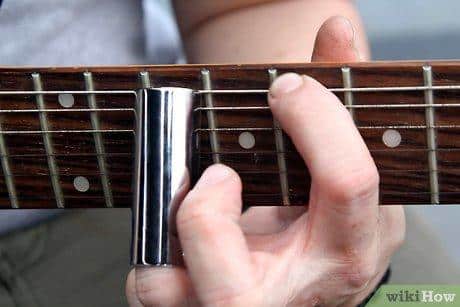
As an author of instructional books, I’ve developed numerous exercises for beginners. I’ll share some of my favorite drills to help you build a solid foundation in slide technique. Start with simple single-string slides, focusing on accuracy and intonation. Practice sliding between two notes, gradually increasing the distance. For fretless bass slides, pay extra attention to your ear training, as precise finger placement is crucial.
Next, try cross-string slides, moving diagonally across the fretboard. This exercise improves your spatial awareness and helps you navigate the neck more fluidly. Incorporate rhythmic patterns into your slides, starting slow and gradually increasing tempo. Remember, consistency in pressure and speed is key to achieving a smooth, professional sound. These basic exercises will significantly enhance your slide technique, preparing you for more advanced applications in your bass playing journey.
Incorporating Slides into Songs

As I’ve transcribed countless bass lines for guitar magazines, I’ve noticed how professional bassists seamlessly integrate slides into their playing. To incorporate slides into songs, start by identifying suitable moments in the music. Transitions between chord changes often present perfect opportunities. Begin with simple, single-note slides before progressing to more complex slide bass techniques. Practice sliding between root notes of chords, gradually expanding to include passing tones and embellishments. Pay attention to the rhythm and timing of your slides, ensuring they complement the song’s groove rather than disrupt it. Experiment with different slide lengths and velocities to add expressiveness. Remember, the goal is to enhance the song, not overshadow it. As you become more comfortable, try incorporating slides into your own bass lines, using them to add fluidity and character to your playing.
Common Mistakes and How to Avoid Them

As an editor for ‘Acoustic Guitar’ magazine, I’ve seen my fair share of slide technique mishaps. Are you unknowingly sabotaging your slide technique? Discover the top 5 mistakes beginners make and learn how to avoid them. First, many players overlook the importance of proper intonation. Sliding to the wrong pitch can derail your entire performance. To combat this, practice sliding to specific frets and use your ears to fine-tune your accuracy.
Another common error is applying too much pressure. Remember, a light touch is key when it comes to bass guitar harmonics slides. Excessive pressure can dampen the strings and muddy your tone. Instead, let the weight of the slide do the work. Third, neglecting your muting technique can lead to unwanted string noise. Use your fretting hand to lightly touch the strings behind the slide to keep things clean.
Fourth, I’ve noticed many beginners rush their slides, losing the smooth, fluid sound that makes this technique so captivating. Take your time and focus on the journey between notes, not just the destination. Lastly, don’t forget about your pick hand! Maintaining consistent attack and dynamics throughout your slide is crucial for a professional sound. By addressing these issues, you’ll be well on your way to mastering the art of bass guitar slides.
FAQs
What is a slide on bass guitar?
How do I perform a basic slide on bass guitar?
1. Play a note on the fretboard
2. Without lifting your finger, slide it up or down to the target note
3. Apply consistent pressure throughout the slide
4. Pluck the string again when you reach the target note for emphasis
What are some tips for improving my bass guitar slides?
1. Practice sliding between specific intervals (e.g., whole steps, octaves)
2. Experiment with different slide speeds
3. Use a metronome to maintain timing
4. Focus on smooth, even pressure throughout the slide
5. Incorporate slides into your regular practice routine
Are there different types of slides on bass guitar?
1. Ascending slides (sliding up the fretboard)
2. Descending slides (sliding down the fretboard)
3. Hammer-on slides (sliding after a hammer-on)
4. Pull-off slides (sliding before a pull-off)
5. Ghost slides (sliding without re-plucking the string)
What common mistakes should beginners avoid when learning slides?
1. Applying inconsistent pressure during the slide
2. Sliding too quickly or too slowly
3. Not practicing with a metronome
4. Neglecting to mute unused strings
5. Focusing solely on ascending slides and ignoring descending ones
Conclusion
Ready to slide your way to bass guitar mastery? Let’s recap the journey and set you on the path to becoming a slide virtuoso. Throughout this article, we’ve explored the fascinating world of bass guitar slides, from understanding their types and benefits to mastering essential techniques. Drawing from my diverse experiences in guitar journalism and education, I’ve shared insights on proper hand positioning, controlling slide speed and pressure, and incorporating slides into your playing.
We’ve covered advanced techniques like combining slides with other bass guitar elements and using bottleneck slides. For beginners, I’ve outlined basic exercises and practice tips to improve your slide technique. Remember, consistent practice and patience are key to mastering bass guitar slide lessons. As you continue your musical journey, embrace the expressive potential of slides and let them elevate your bass playing to new heights. Keep exploring, keep practicing, and most importantly, enjoy the unique sound and feel that slides bring to your bass guitar repertoire.